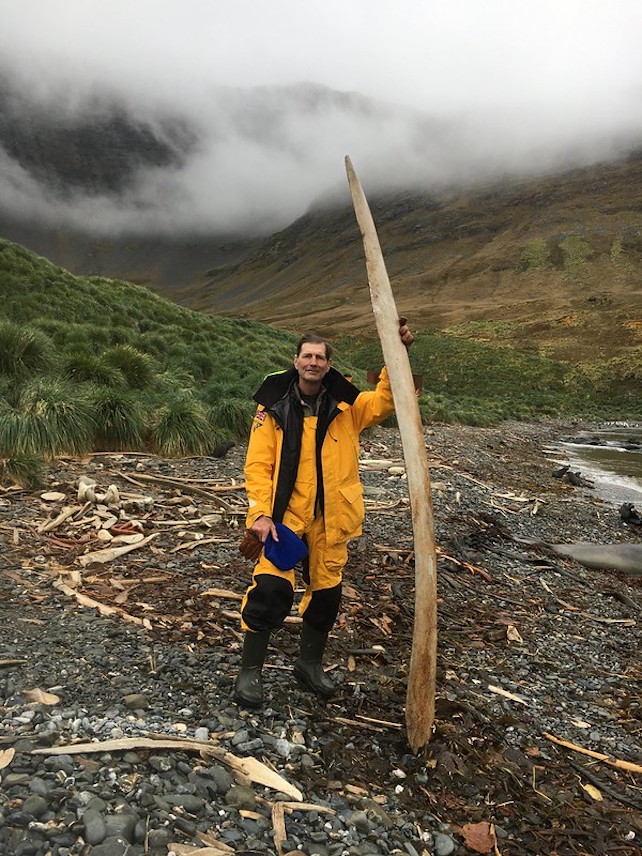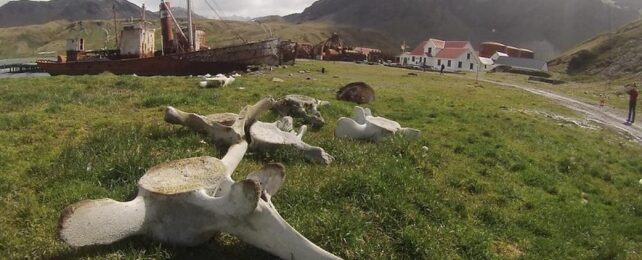Whale hunting in the 20th century significantly reduced the genetic diversity of the ocean giants, with particularly devastating effects on two species.
The commercial whaling industry spent centuries slaughtering whales around the world for their oil and meat, wiping out some populations and driving many species to the brink of extinction.
An international moratorium on commercial whaling eventually helped stem the slaughter; some populations have even begun modest recoveries. According to a new study, however, the grim legacy of the whaling era still haunts its survivors' progeny.
Researchers discovered this by examining whale bones found on beaches near abandoned whaling stations at South Georgia Island in the South Atlantic Ocean. Some of the bones are more than 100 years old, but well-preserved by South Georgia's cold tundra climate.
The international team compared DNA from those old bones with DNA from whales living in the area today, focusing on three species in the South Atlantic: blue, fin, and humpback whales.
Their findings suggest last century's whaling had a significant effect on especially blue (Balaenoptera musculus) and humpback whales (Megaptera novaeangliae), which seem to have lost entire maternal DNA lineages.
"A maternal lineage is often associated with an animal's cultural memories such as feeding and breeding locations that are passed from one generation to the next," says first author and marine ecologist Angela Sremba of Oregon State University's Marine Mammal Institute.
"If a maternal lineage is lost, that knowledge is likely also lost."
As whale populations declined elsewhere, commercial whalers increasingly targeted the Southern Hemisphere in the early 20th century, setting up whaling stations in remote places like South Georgia, located about 1,300 kilometers east of the Falkland Islands.
Between the turn of the century and the 1960s, whalers killed more than 2 million whales in the Southern Hemisphere alone, including about 175,000 near South Georgia.
The island hosted several whaling stations during that period, and its landscape remains strewn with thousands of washed-up whale bones that had been discarded in the ocean once the bodies were processed, the researchers note.
Although some whale populations in the South Atlantic are now recovering, many are still well below their estimated pre-whaling numbers, due both to the scale of last century's slaughter as well as the slow reproductive rates of large baleen whales like these.

These big whales are also still rarely seen in some habitats frequented by their ancestors – including waters around South Georgia. This suggests populations may have been extirpated, or driven locally extinct, the researchers say.
"For 60 years, the whales have been absent from the South Georgia feeding grounds, suggesting that cultural memory was lost," says Scott Baker, a marine biologist at Oregon State's Marine Mammal Institute.
"The numbers of whales returning to this region today are still not large," he adds, "but there is a sense that they may be rediscovering this habitat."
Modern blue, humpback, and fin (Balaenoptera physalus) whales in these waters still have fairly high genetic diversity, the study found, seemingly justifying at least cautious optimism for their overall recovery.
Among the blues and humpbacks, however, the comparison of DNA from early 20th-century bones with DNA from modern whales points to the loss of ancient maternal DNA lineages.
Most whales alive today are likely descendants of the whales who faced this onslaught from humans, but as Sremba points out, some survivors of the commercial whaling era might still be out there.
Many large whales are known for their impressive longevity, and all three species examined in this study can live for 90 years or more.
Any survivors from the early 20th century would be nearing the end of their life spans, though, and as they die out, it could mean the loss of even more maternal DNA lineages.
That adds a sense of urgency to studies like this, Sremba says, noting we have a fleeting opportunity to record genetic information about these elder whales while they're still with us.
"It's remarkable these species survived," she says. "In another 100 years, we don't know what might change, and we can't measure any change now if we don't have a good understanding of the past."
By helping us reconstruct the history of whale populations, this kind of research can shed more light on what was lost due to commercial whaling, the researchers say, and could boost efforts to protect whatever wasn't.
And while South Georgia's chilly climate has helped preserve DNA in these bones for researchers to study a century later, that protection may fade as climate change raises temperatures on the island, Baker notes.
"This work is a way to preserve this history indefinitely," he says.
The study was published in the Journal of Heredity.
